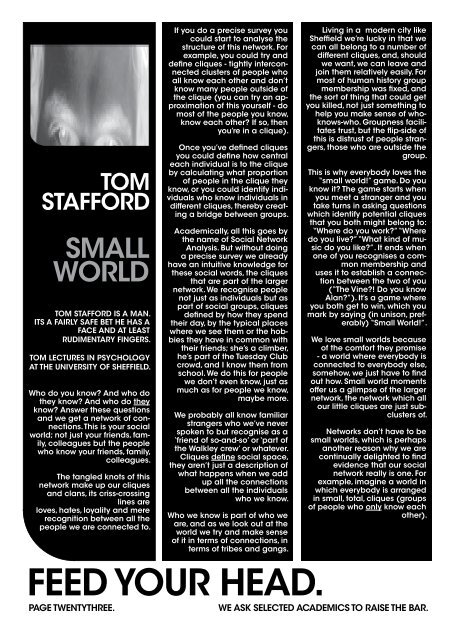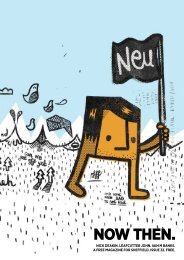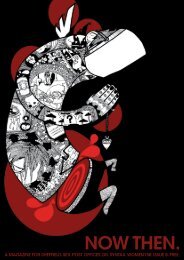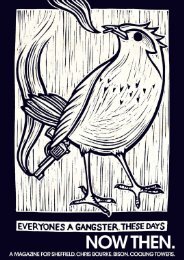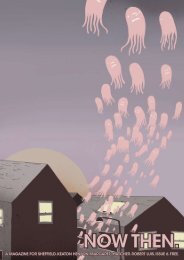You also want an ePaper? Increase the reach of your titles
YUMPU automatically turns print PDFs into web optimized ePapers that Google loves.
nOw tHEn welcomes all feedback on all <strong>of</strong> our articles, get online at nOwtHEnsHEFFiElD.cOm and join in on the forum.<br />
tOm<br />
stAFFORD<br />
smAll<br />
wORlD<br />
tOm stAFFORD is A mAN.<br />
its A FAiRlY sAFE bEt HE HAs A<br />
FAcE AND At lEAst<br />
RUDimENtARY FiNGERs.<br />
tOm lEctUREs iN PsYcHOlOGY<br />
At tHE UNivERsitY OF sHEFFiElD.<br />
who do you know? And who do<br />
they know? And who do they<br />
know? Answer these questions<br />
and we get a network <strong>of</strong> connections.<br />
this is your social<br />
world; not just your friends, family,<br />
colleagues but the people<br />
who know your friends, family,<br />
colleagues.<br />
the tangled knots <strong>of</strong> this<br />
network make up our cliques<br />
and clans, its criss-crossing<br />
lines are<br />
loves, hates, loyality and mere<br />
recognition between all the<br />
people we are connected to.<br />
if you do a precise survey you<br />
could start to analyse the<br />
structure <strong>of</strong> this network. For<br />
example, you could try and<br />
define cliques - tightly interconnected<br />
clusters <strong>of</strong> people who<br />
all know each other and don’t<br />
know many people outside <strong>of</strong><br />
the clique (you can try an approximation<br />
<strong>of</strong> this yourself - do<br />
most <strong>of</strong> the people you know,<br />
know each other? if so, then<br />
you’re in a clique).<br />
Once you’ve defined cliques<br />
you could define how central<br />
each individual is to the clique<br />
by calculating what proportion<br />
<strong>of</strong> people in the clique they<br />
know, or you could identify individuals<br />
who know individuals in<br />
different cliques, thereby creating<br />
a bridge between groups.<br />
Academically, all this goes by<br />
the name <strong>of</strong> social Network<br />
Analysis. but without doing<br />
a precise survey we already<br />
have an intuitive knowledge for<br />
these social words, the cliques<br />
that are part <strong>of</strong> the larger<br />
network. we recognise people<br />
not just as individuals but as<br />
part <strong>of</strong> social groups, cliques<br />
defined by how they spend<br />
their day, by the typical places<br />
where we see them or the hobbies<br />
they have in common with<br />
their friends; she’s a climber,<br />
he’s part <strong>of</strong> the tuesday club<br />
crowd, and i know them from<br />
school. we do this for people<br />
we don’t even know, just as<br />
much as for people we know,<br />
maybe more.<br />
we probably all know familiar<br />
strangers who we’ve never<br />
spoken to but recognise as a<br />
‘friend <strong>of</strong> so-and-so’ or ‘part <strong>of</strong><br />
the walkley crew’ or whatever.<br />
cliques define social space,<br />
they aren’t just a description <strong>of</strong><br />
what happens when we add<br />
up all the connections<br />
between all the individuals<br />
who we know.<br />
who we know is part <strong>of</strong> who we<br />
are, and as we look out at the<br />
world we try and make sense<br />
<strong>of</strong> it in terms <strong>of</strong> connections, in<br />
terms <strong>of</strong> tribes and gangs.<br />
living in a modern city like<br />
sheffield we’re lucky in that we<br />
can all belong to a number <strong>of</strong><br />
different cliques, and, should<br />
we want, we can leave and<br />
join them relatively easily. For<br />
most <strong>of</strong> human history group<br />
membership was fixed, and<br />
the sort <strong>of</strong> thing that could get<br />
you killed, not just something to<br />
help you make sense <strong>of</strong> whoknows-who.<br />
Groupness facilitates<br />
trust, but the flip-side <strong>of</strong><br />
this is distrust <strong>of</strong> people strangers,<br />
those who are outside the<br />
group.<br />
this is why everybody loves the<br />
“small world!” game. Do you<br />
know it? the game starts when<br />
you meet a stranger and you<br />
take turns in asking questions<br />
which identify potential cliques<br />
that you both might belong to:<br />
“where do you work?” “where<br />
do you live?” “what kind <strong>of</strong> music<br />
do you like?”. it ends when<br />
one <strong>of</strong> you recognises a common<br />
membership and<br />
uses it to establish a connection<br />
between the two <strong>of</strong> you<br />
(“the vine?! Do you know<br />
Alan?”). it’s a game where<br />
you both get to win, which you<br />
mark by saying (in unison, preferably)<br />
“small world!”.<br />
we love small worlds because<br />
<strong>of</strong> the comfort they promise<br />
- a world where everybody is<br />
connected to everybody else,<br />
somehow, we just have to find<br />
out how. small world moments<br />
<strong>of</strong>fer us a glimpse <strong>of</strong> the larger<br />
network, the network which all<br />
our little cliques are just subclusters<br />
<strong>of</strong>.<br />
Networks don’t have to be<br />
small worlds, which is perhaps<br />
another reason why we are<br />
continually delighted to find<br />
evidence that our social<br />
network really is one. For<br />
example, imagine a world in<br />
which everybody is arranged<br />
in small, total, cliques (groups<br />
<strong>of</strong> people who only know each<br />
other).<br />
if you picked two strangers at<br />
random from this world, unless<br />
you happened to pick two people<br />
from the same clique, the<br />
chances are that they wouldn’t<br />
know each other - but not only<br />
that, they wouldn’t have any<br />
mutual friends either. there’d be<br />
no surprising connection to be<br />
found, no small world. the same<br />
thing is true for less extreme<br />
versions <strong>of</strong> the same network,<br />
the more ‘cliqueyness’ in a network<br />
the less chance there is<br />
that any two random individuals<br />
will have a connection.<br />
the paradox <strong>of</strong> this is that<br />
although cliques make up our<br />
social worlds, and define the<br />
landscape which we use to<br />
discover these suprising ‘smallworld’<br />
connections, cliqueyness<br />
is actually in direct competition<br />
with connectivity. if you only<br />
know people who know each<br />
other you won’t have any connection<br />
to new people. You can<br />
also imagine the situation from<br />
the other direction: a world<br />
where nobody you knew knew<br />
anybody else you knew would<br />
also be a world where you had<br />
short connection to everybody.<br />
You would’t want to live in this<br />
world, however - imagine never<br />
knowing directly more than<br />
one person in a group.<br />
so cliqueyness and suprising<br />
connections look like they form<br />
a trade-<strong>of</strong>f, with cliqueyness<br />
helping us to make sense <strong>of</strong><br />
the world, but doing so at the<br />
cost <strong>of</strong> limiting our ability to<br />
connect to strangers.<br />
this would be a sad story but<br />
for the discovery made a few<br />
years ago by two American<br />
network theoriests, Duncan<br />
watts and steve strogatz.<br />
they discovered something<br />
about networks which means<br />
that you don’t have to lose a<br />
suprising connectedness if you<br />
keep a high degree <strong>of</strong><br />
cliqueyness. what at first looks<br />
like a trade-<strong>of</strong>f, for a suprising<br />
reason, turns out not to be.<br />
watts and strogatz were looking<br />
mathematically at the two<br />
properties <strong>of</strong> networks we’ve<br />
already considered: cliqueyness<br />
and connectivity (which<br />
they define as ’average minimum<br />
path length’, the average<br />
shortest distance between all<br />
pairs <strong>of</strong> individuals in the network).<br />
like us, they considered<br />
completely cliquey worlds with<br />
very low levels <strong>of</strong> connectivity<br />
and they considered completely<br />
randomly connected<br />
world, which have low cliqueyness<br />
and high connectivity<br />
(short average minimum path<br />
length). their discovery came<br />
when they used computer<br />
simulation to measure, step by<br />
step, what happened when<br />
you changed a highly cliqued<br />
network towards a completely<br />
random one.<br />
inspecting cliqueyness they<br />
found what you might expect;<br />
as you make connections in a<br />
cliquey network more random<br />
the degree <strong>of</strong> cliqueyness decreases<br />
steadily. the suprise is<br />
what happens to connectivity.<br />
Rather than change steadily,<br />
the connectivity <strong>of</strong> a cliquey<br />
network increases with massive<br />
rapidity as you add random<br />
connections. Just a few<br />
connections between cliques<br />
makes everyone in the network<br />
closer to everyone else. it<br />
seems there is a sweet spot,<br />
inbetween the two extreme<br />
kinds <strong>of</strong> networks, where<br />
each individual in the network<br />
is still in a clearly defined<br />
clique, but everybody is also<br />
closely connected to everybody<br />
else. watts and strogatz<br />
called networks that existed in<br />
this sweet spot ‘small<br />
worlds’, for obvious reasons.<br />
Armed with this definition scientists,<br />
starting with watts and<br />
strogatz, looked around for<br />
real-world networks they could<br />
analyse. Example after example<br />
turned out to be ‘smallworlds’.<br />
the electricity power<br />
grid in the Us, the network <strong>of</strong><br />
collaboration between Hollywood<br />
actors, the neural<br />
networks in the brains <strong>of</strong><br />
worms and humans.<br />
‘small worldness’ seemed to be<br />
something that many different<br />
kinds <strong>of</strong> networks have; not<br />
just something that’s do to with<br />
social networks and our love <strong>of</strong><br />
finding suprising connections<br />
with strangers.<br />
the reason for this ubiquity may<br />
lie in the way small world networks<br />
combine local structure<br />
(cliqueyness) with global connectivity.<br />
to an individual who<br />
is part <strong>of</strong> small world network it<br />
looks pretty much like a world<br />
<strong>of</strong> cliques --- most <strong>of</strong> the<br />
people (or power stations, or<br />
brain cells, or collaborators)<br />
you know also know most <strong>of</strong><br />
the other people (power stations/braincells/collaborators)<br />
you know. But despite this<br />
‘ground level’ view <strong>of</strong> things<br />
nobody in any clique is very far<br />
away from anybody else. Just<br />
a few extra-clique connections<br />
are enough to make the whole<br />
network connected. this means<br />
that information (gossip, electricity,<br />
neural signals, whatever)<br />
can spread through the network<br />
easily.<br />
As individuals we can only see<br />
the larger network in terms <strong>of</strong><br />
who we know, and in terms <strong>of</strong><br />
the cliques we can make out,<br />
but there is a larger network<br />
out there which we, and our<br />
cliques, are just a tiny part <strong>of</strong>.<br />
And this whole network is a<br />
community, full <strong>of</strong> suprising<br />
connections between any pair<br />
<strong>of</strong> individuals that you choose<br />
to pick. things like information,<br />
opinions, diseases and fashions<br />
spread through this network<br />
rapidly, taking advantage<br />
<strong>of</strong> these suprising connections.<br />
if we’re lucky we occasionally<br />
get a glimpse <strong>of</strong> them ourselves,<br />
when we find a suprising<br />
connection to a stranger.<br />
But whether we do or we don’t<br />
we shouldn’t forget that we are<br />
always connected to the larger<br />
network, and what we do can<br />
affect everyone.<br />
it is, after all, a small world.<br />
FEED YOUR HEAD.<br />
PAGE twENtYtHREE.<br />
wE Ask sElEctED AcADEmics tO RAisE tHE bAR.<br />
FEED YOUR HEAD.<br />
tHis mOntH tOm stAFFORD spEAks On sOciAl nEtwORks.<br />
pAGE twEntYFOUR.


